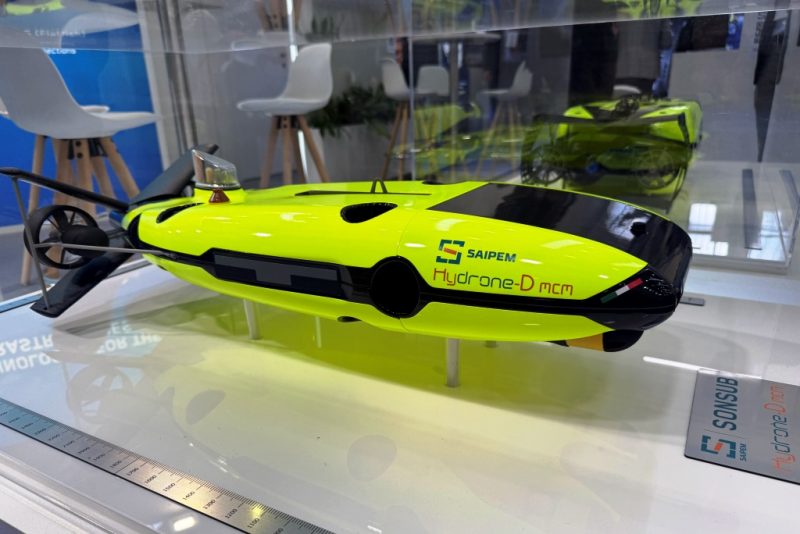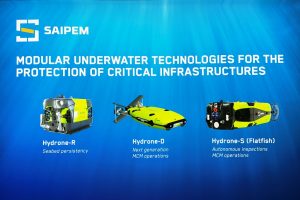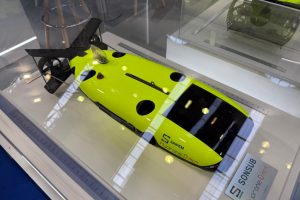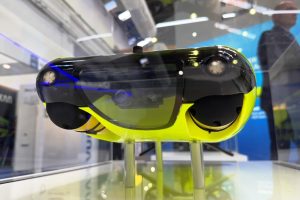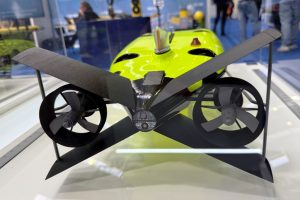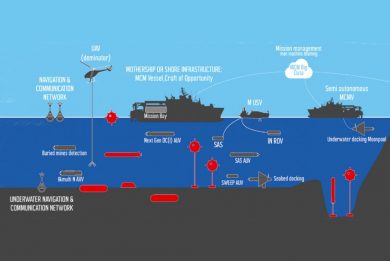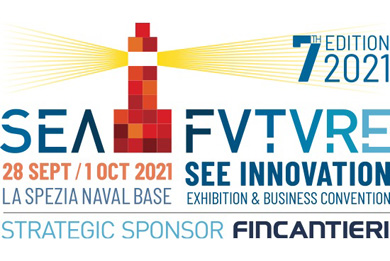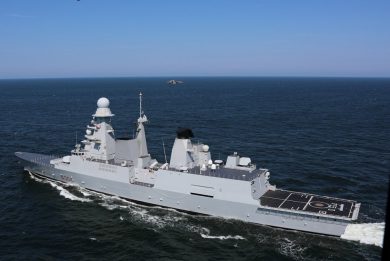Seafuture 2025 – Saipem’s Sonsub unveils Hydrone-D MCM for Italian Navy
Leveraging on the unique experience and capabilities in the field-proven underwater drones in service for the Oil and Gas market, at Seafuture 2025 Saipem’ Sonsub unveiled the Hydrone-D, the first platform specifically developed for the defence market, which launch customer is the Italian Navy
Based on the family of Hydrone hybrid autonomous underwater vehicle-remotely operated vehicles (AUV-ROVs) developed for civilian applications including the Hydrone-R, operational on a long-term service contract offshore Norway, and Flatfish, which has demonstrated its capability to safely operate from very shallow to deep waters, Sonsub, Saipem’s Centre of Excellence for underwater technologies and robotics based in Marghera and Trieste, designed an innovative hybrid AUV/ROV for mine countermeasures and inspection of critical underwater infrastructures.
The Hydrone-D MCM is the result of the last four years of engineering development, based on almost 10 years of Hydrone Platform engineering, testing and operations and it has been selected for the Italian Navy fleet of new Mine CounterMeasures Vessels (MCMVs) under the New Generation Minehunters/Coastal (NGM/C) or Cacciamine Nuova Generazione Costieri (CNG/C) programme. These MCMVs were designed and the first is under construction by Intermarine shipbuilder, part of IMMSI group, as prime of a temporary grouping of companies together with Leonardo.
The Hydrone-D MCM is a hybrid AUV-ROV with hovering capability, featuring a modular architecture that enables multiple configurations for critical defence missions. The new platform unlocks advanced modes of operation for the whole set of tasks part of MCM missions, with high level of autonomy and advanced manoeuvrability. Exploiting the full MCM suite, in a single mission the Hydrone-D MCM can accomplish up to four neutralization operations, according to the Saipem representative.
With a length and beam of around 3.5 and 1.5 metres, a height of less than one metre, and a maximum mass of less than 900 kg in an undisclosed baseline configuration, the platform being still under development and few details being unveiled, the Hydrone-D MCM has been specifically developed for dedicated defence operations; it is characterized by high modularity, any vehicle configuration being set up by manually assembling carrier and mission modules. Featuring low acoustic and magnetic signature, according to STANAG 1364 NATO, it incorporates hovering capabilities with six controlled degrees of freedom (surge, sway, heave, roll, pitch, yaw) thanks to four thrusters (two laterally and two vertically positioned) and two stern propellers and can be operated in a tethered (ROV) or autonomous (AUV) configuration. Although the configuration is still to be completed, forward and bottom sections are reserved for mission equipment and sensors, while the rear section hosts propulsion, thrusters, and batteries.
With a max operating depth of 600 metres and equipped with lithium-ion batteries, the Hydrone-D can be launched and recovered by a shipborne crane of opportunity or at depth by a docking module. Based on the experience developed in the Oil and Gas market, to allow safer and less-sea condition dependent operations, Sonsub has developed a docking module customizable to the selected platform and to specific customer requirements, where the drone is placed before being lowered into the water at the operational depth, where it is released and recovered after the mission. In this way, the launch and recovery operations are less dependent on the platform movements, higher currents found in the surface waters and offer reduced power consumption due to reduced transit time to the operating zone.
The Hydrone-D MCM can be equipped with a full navigation and positioning suite including INS + DVL + depth meter, GPS receiver, obstacle avoidance sonar, altimeter, sound velocity meter, USBL (Ultra-Short BaseLine) underwater positioning transceiver, the latter controlling unit offering automatic functions. They include auto depth, altitude, heading, pitch, speed control, anti-collision and obstacle avoidance, way-point navigation, station keeping/hovering – target relative navigation, parking inside the docking module, seabed pipeline and vertical line tracking. The communication suite can include the tether connector, acoustic modem, and WiFi antenna while the emergency one can feature a data sterilisation system, quick surfacing system, radio beacon, and flasher.
As anticipated, the Hydrone-D MCM can accommodate a wide range of sensors, making the platform sensor-agnostic, and can carry up to four countercharges to carry out search, classification, identification, and neutralization of bottom and moored mine or improvised explosive device threats, in addition to seabed warfare including critical underwater infrastructure surveillance and protection. Equipped with side-scan sonar, optical cameras and imaging sonar, the Hydrone-D MCM can conduct bottom mines search, classification, and identification, while with cameras, imaging sonar and countercharges, it can accomplish identification and neutralization of bottom or moored mines. Being equipped with cameras, imaging sonar, optical 3D reconstruction system, the Hydrone-D MCM can conduct seabed survey and mapping, with pipeline tracking, classification and identification of seabed objects, data gathering of infrastructures resident on the seabed.
Photos by L. Peruzzi

